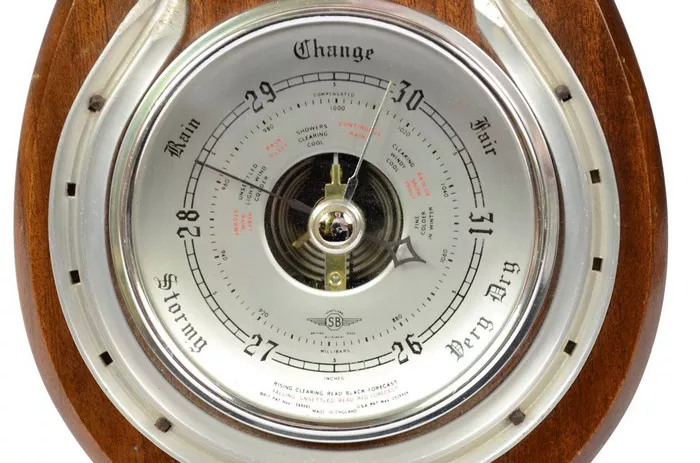A stick barometer is one of the earliest and most reliable instruments used to measure atmospheric pressure. It is based on the principles of fluid mechanics and hydrostatics and has played a crucial role in meteorology and scientific research since its invention in the 17th century.
This article explains the working principles of a stick barometer, its components, and its role in measuring atmospheric pressure. We will also discuss its history, advantages, and limitations, making it easy for both enthusiasts and students to understand.
Historical Background of the Stick Barometer
The stick barometer was developed based on the foundational experiments of Evangelista Torricelli, an Italian physicist and mathematician. In 1643, Torricelli conducted an experiment using a glass tube filled with mercury and inverted it into a container of the same liquid. He observed that the mercury level in the tube dropped, leaving an empty space at the top, and concluded that this was due to atmospheric pressure exerted on the mercury in the container. This experiment led to the invention of the first mercury barometer, which evolved into the stick barometer over time.
Components of a Stick Barometer
A stick barometer consists of several essential components that allow it to function effectively:
- Glass Tube – A long, sealed glass tube that is filled with mercury or another liquid.
- Reservoir (Cistern) – A container at the bottom that holds the mercury and allows the tube to be inverted into it.
- Scale (Graduated Scale or Vernier Scale) – A calibrated scale placed alongside the tube to measure the height of the mercury column. The scale is often marked in millimeters (mmHg) or inches of mercury (inHg).
- Mounting Frame – A wooden or metallic case that supports and protects the glass tube and scale.
- Filling Port and Adjustment Screw – Some barometers have a mechanism to adjust the mercury level for calibration.
Working Principle of a Stick Barometer
The stick barometer works based on the principle of hydrostatic equilibrium and atmospheric pressure. The operation can be understood in the following steps:
Step 1: Filling the Tube with Mercury
A long glass tube is completely filled with mercury and then inverted into a reservoir of mercury. Since mercury is a heavy liquid, it attempts to flow down due to gravity. However, the top of the tube is sealed, preventing air from entering.
Step 2: Formation of a Vacuum
As the mercury settles, it creates a vacuum at the top of the tube. This vacuum, known as the Torricellian vacuum, plays a crucial role in measuring atmospheric pressure.
Step 3: Atmospheric Pressure Balances the Mercury Column
The mercury in the reservoir is exposed to atmospheric pressure. This pressure pushes mercury up into the tube, balancing the column of liquid against the weight of the air above the reservoir. The height of the mercury column stabilizes at a point where the downward gravitational force of the mercury equals the force exerted by atmospheric pressure.
Step 4: Measuring Atmospheric Pressure
The height of the mercury column in the tube indicates the atmospheric pressure. On an average day at sea level, the mercury column stands at 760 mmHg (29.92 inHg), which is equivalent to 1013.25 millibars (mb) or 1 atmosphere (atm).
Step 5: Variations in Atmospheric Pressure
When the atmospheric pressure increases, it exerts more force on the mercury in the reservoir, pushing more mercury into the tube, raising the column height. Conversely, when the atmospheric pressure decreases, the column height drops. These changes in height allow meteorologists and scientists to measure pressure variations and predict weather conditions.
Factors Affecting the Performance of a Stick Barometer
Several factors influence the accuracy and effectiveness of a stick barometer:
- Temperature Changes – Mercury expands and contracts with temperature variations, slightly affecting readings. Modern barometers include temperature compensation mechanisms to correct this error.
- Altitude Effects – At higher altitudes, atmospheric pressure is lower, resulting in lower mercury column heights. Barometric readings must be adjusted based on altitude.
- Instrument Tilt and Calibration – A tilted barometer may provide incorrect readings. Proper calibration and mounting ensure precise measurements.
- Mercury Purity – Impurities in the mercury can lead to inconsistent readings due to surface tension effects and contamination.
Uses and Applications of a Stick Barometer
Stick barometers have been widely used for various applications, including:
- Weather Prediction – Meteorologists use barometers to track pressure changes and forecast storms, rain, or fair weather.
- Aviation and Navigation – Barometric readings assist in altitude measurement and weather monitoring for aircraft and ships.
- Scientific Research – Atmospheric studies and experiments in fluid dynamics use barometers to measure air pressure.
- Calibration of Modern Instruments – Stick barometers serve as reference instruments to calibrate electronic pressure sensors.
Advantages of a Stick Barometer
- High Accuracy – Mercury barometers provide precise pressure measurements.
- Durability – Unlike aneroid barometers, stick barometers have fewer moving parts and last longer.
- Simple Design – The basic design is easy to understand and requires minimal maintenance.
Limitations of a Stick Barometer
- Mercury Hazards – Mercury is toxic, and spills can pose health risks.
- Fragility – The glass tube is delicate and can break easily.
- Limited Portability – Due to its size and mercury content, it is not as portable as modern digital barometers.
Conclusion
The stick barometer is a remarkable instrument based on fundamental physics principles, providing accurate atmospheric pressure measurements for centuries. Although modern digital sensors have largely replaced it, its historical significance and reliability make it an essential tool in meteorology and science. Understanding its working principle helps us appreciate the ingenuity of early scientists and the foundational role it played in weather forecasting and atmospheric studies.

